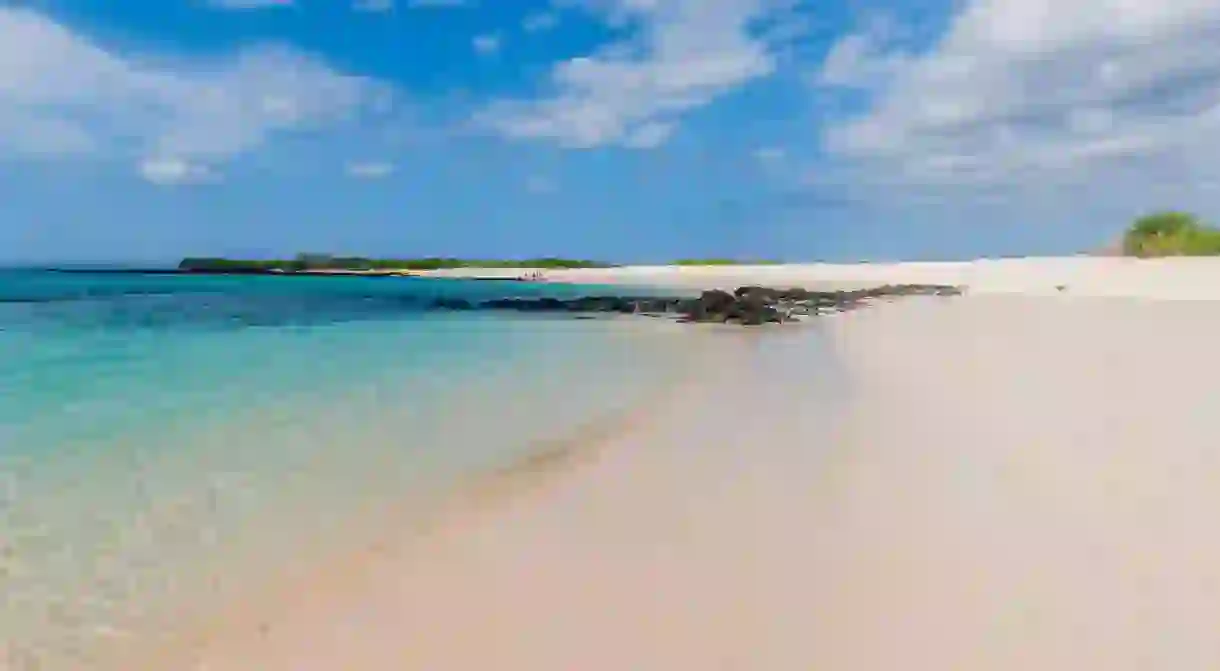The Most Beautiful Beaches in the Galapagos Islands

The Galápagos Islands are not only home to some of the most unique species in the world, but they also have among the most beautiful beaches. Relax with sea lions, iguanas, and birds on the whitest sand you’ve ever curled your toes into. Here’s a guide to the best beaches in the Galápagos Islands.
Time is short on the Galápagos Islands, so you’ll want to make the most of yours. Join our five-day trip to ensure you get fast-tracked to all the top spots for wildlife encounters, with a dedicated Local Insider leading the way.
Tortuga Bay, Santa Cruz Island
Natural Feature
Tortuga Bay is the most popular beach to visit on the Galápagos Islands and frequently ranked as one of the best beaches in the world. To get there, it’s a 30-minute walk from central Puerto Ayora. You’ll know when you’ve arrived when you see marine iguanas chilling in the white sand and in the turquoise water. As you may have guessed by the name, Tortuga Bay is a great place to be during turtle nesting season.
Bartolome Island beach
Natural Feature
Bartolome is famous for its iconic landscape and in particular the Pinnacle Rock. Forming part of a pink and white crescent-shaped cove, the beach is a a sightseer’s paradise – with sea turtles, penguins, and playful sea lions all regular visitors. For a closer look, bring your snorkelling gear.
El Garrapatero, Santa Cruz Island
Natural Feature
El Garrapatero is a gorgeous and less crowded beach around 30 minutes’ drive from Puerto Ayora. Get there early enough and you may find you have the place all to yourself – with the exception of a few sea lions, flamingos and blue-footed boobies, of course. Don’t forget to bring a mask and snorkel – as well as colourful fish, you may just encounter a sea turtle in the tidal pools just off shore, or even a Galápagos penguin if you’re luck is really in.
Post Office Bay, Floreana Island
Natural Feature
There is a fascinating story behind how Post Office Bay got its name. It goes that 18th-century homesick whalers would leave letters here for the crew of passing ships en route to the US to collect and post for them when they got to the mainland. The mail could take months, or even years to deliver. And yet the enterprise is still operating today. Many tourists drop their own mail in the post box – no doubt the latest of many since perished – and collect previously left mail to deliver it themselves upon their return. The beach itself is popular for spotting Darwin finches, yellow warblers, lava lizards and – in the shallow waters – green pacific sea turtles and sea lions. Moreover, this island is known for its endemic vegetation.
Puerto Chino, San Cristobal
Natural Feature
Follow a pathway for 20 minutes from the parking lot and you will find the beautiful Puerto Chino beach. It’s a great place for families and to cool off in the afternoon. At this rocky beach you can spot finches and sea lions.
Bachas Beach, Santa Cruz
Natural Feature
Bachas Beach is located just north of Santa Cruz, and a solid bet if you’re looking for calm waves only. Keep your eyes peeled for light-footed crabs and Galápagos flamingos in the lagoon. As for how this beach got its name, see if you can find the rusty barge abandoned here during WWII – the saying goes locals couldn’t pronounce ‘barges’ and settled for ‘Bachas’ instead.
Puerto Villamil, Isabela Island
Natural Feature
Puerto Villamil beach is one of the longest beaches on the Galápagos Islands, stretching for about 3 km. The beach is a paradise for flamingos and you are certain to spot marine iguanas either lounging on the sand or gliding through the clear water with that long tail of theirs trailing behind them.
Red Sand Beach, Rabida Island
Natural Feature
It’s not often you sunbathe on a red-sand beach, but the literally named Red Sand beach on Rabida Island allows you to do just that – alongside blue-footed boobies, brown pelicans, finches and sea lions. Needless to say, if you’re on the hunt for an eye-popping Instagram post, this is where you’ll find it.













